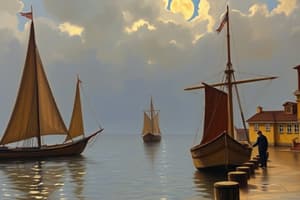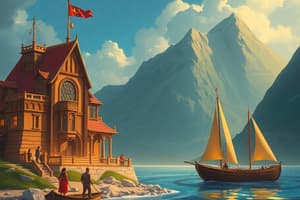Podcast
Questions and Answers
Explain how Adam Smith and David Ricardo challenged the Mercantilist view on trade and what alternative perspective did they propose?
Explain how Adam Smith and David Ricardo challenged the Mercantilist view on trade and what alternative perspective did they propose?
Smith and Ricardo argued trade can be mutually beneficial, not a zero-sum game, proposing specialization based on comparative & absolute advantage.
Describe the concept of absolute advantage in international trade and provide a hypothetical example to illustrate it.
Describe the concept of absolute advantage in international trade and provide a hypothetical example to illustrate it.
Absolute advantage is when a country can produce a good using fewer resources than another. For example, if Country A can produce 10 tons of wheat per hour while Country B produces 4, Country A has absolute advantage in wheat.
Explain the law of comparative advantage and why it suggests that trade can still be mutually beneficial even if one nation has an absolute advantage in producing all goods.
Explain the law of comparative advantage and why it suggests that trade can still be mutually beneficial even if one nation has an absolute advantage in producing all goods.
Comparative advantage states that even if a nation is less efficient (has absolute disadvantage) in producing both goods compared to another nation, there is still a basis for mutually beneficial trade. This is because each country benefits by specializing in what it produces at a lower opportunity cost.
What is the primary distinction between the Heckscher-Ohlin model and earlier trade theories like those of Adam Smith and David Ricardo?
What is the primary distinction between the Heckscher-Ohlin model and earlier trade theories like those of Adam Smith and David Ricardo?
Identify and briefly describe two key new trade theories that attempt to explain patterns of international trade that the Heckscher-Ohlin model does not adequately address.
Identify and briefly describe two key new trade theories that attempt to explain patterns of international trade that the Heckscher-Ohlin model does not adequately address.
Define 'Hicksian Technical Progress' and briefly describe its characteristics.
Define 'Hicksian Technical Progress' and briefly describe its characteristics.
Summarize the effects of labor-saving technical progress and capital-saving technical progress, respectively, on productivity and the relative use of labor versus capital.
Summarize the effects of labor-saving technical progress and capital-saving technical progress, respectively, on productivity and the relative use of labor versus capital.
What is the key difference between an ad valorem tariff and a specific tariff, and how are they applied to traded commodities?
What is the key difference between an ad valorem tariff and a specific tariff, and how are they applied to traded commodities?
Describe the primary goal of 'strategic business decision-making' and explain how it differs from regular operational decisions.
Describe the primary goal of 'strategic business decision-making' and explain how it differs from regular operational decisions.
List and briefly describe three key elements that are crucial for effective strategic decision-making.
List and briefly describe three key elements that are crucial for effective strategic decision-making.
Explain how adhering to Environmental, Social, and Governance (ESG) considerations contributes to ensuring the sustainability of a company.
Explain how adhering to Environmental, Social, and Governance (ESG) considerations contributes to ensuring the sustainability of a company.
Identify two internal factors that often shape a company's strategic decisions and provide an example of how each might influence decision-making.
Identify two internal factors that often shape a company's strategic decisions and provide an example of how each might influence decision-making.
Describe how 'market conditions' and the 'economic environment' can influence strategic business decisions.
Describe how 'market conditions' and the 'economic environment' can influence strategic business decisions.
Briefly describe two common frameworks that businesses use to analyze their strategic situation and make informed decisions.
Briefly describe two common frameworks that businesses use to analyze their strategic situation and make informed decisions.
List three potential challenges in strategic business decision-making and suggest a solution to mitigate each challenge.
List three potential challenges in strategic business decision-making and suggest a solution to mitigate each challenge.
How do labor policies and institutions influence the relationship between workers and employers?
How do labor policies and institutions influence the relationship between workers and employers?
Explain how education and skills enhance individuals’ productivity, employability, and earnings while reducing the risk of unemployment?
Explain how education and skills enhance individuals’ productivity, employability, and earnings while reducing the risk of unemployment?
Describe the key components of labor markets, including the roles of workers and employers in determining wages and working conditions.
Describe the key components of labor markets, including the roles of workers and employers in determining wages and working conditions.
How do technological advancements and increasing worker preferences affect labor markets and the demand for certain skills?
How do technological advancements and increasing worker preferences affect labor markets and the demand for certain skills?
What is 'human capital', and how does it enhance the productivity, earnings, and overall success of individuals in the labor market?
What is 'human capital', and how does it enhance the productivity, earnings, and overall success of individuals in the labor market?
Flashcards
Comparative Advantage
Comparative Advantage
An economic principle that states that a country can produce a good or service at a lower cost than other country
Heckscher-Ohlin Model
Heckscher-Ohlin Model
Trade theory based on factor endowments.
New Trade Theory (NTT)
New Trade Theory (NTT)
Explains trade between similar countries using economies of scale and market imperfections.
Import Tariff
Import Tariff
Signup and view all the flashcards
Export Tariff
Export Tariff
Signup and view all the flashcards
Ad Valorem Tariff
Ad Valorem Tariff
Signup and view all the flashcards
Strategic Business Decision-Making
Strategic Business Decision-Making
Signup and view all the flashcards
SWOT Analysis
SWOT Analysis
Signup and view all the flashcards
PESTEL Analysis
PESTEL Analysis
Signup and view all the flashcards
Labor Economics
Labor Economics
Signup and view all the flashcards
Labor Force Participation Rate
Labor Force Participation Rate
Signup and view all the flashcards
Unemployment Rate
Unemployment Rate
Signup and view all the flashcards
Human Capital
Human Capital
Signup and view all the flashcards
Labor Markets
Labor Markets
Signup and view all the flashcards
Labor Supply Curve
Labor Supply Curve
Signup and view all the flashcards
Labor Demand Curve
Labor Demand Curve
Signup and view all the flashcards
Labor Policies
Labor Policies
Signup and view all the flashcards
Study Notes
International Business Economics: Mercantilist Views on Trade
- Mercantilists measured wealth by precious metals, while today wealth is measured by human capital, manufactured goods, services availability, and productive resources.
- Thomas Munn's work, England's Treasure by Foreign Trade, stressed exporting more than importing to prevent losing gold and silver.
- Mercantilists viewed global wealth as a zero-sum game, where one nation's gain meant another's loss, leading to trade conflicts.
- Adam Smith and David Ricardo critiqued mercantilism, advocating mutually beneficial trade.
Trade Based on Absolute Advantage
- Adam Smith, a Scottish economist and philosopher known as the "Father of Economics" or "Father of Capitalism,"
- Smith wrote The Wealth of Nations in 1776; his ideas influenced classical economists like David Ricardo and John Stuart Mill.
- Smith's theories include the invisible hand, laissez-faire economics, division of labor and specialization, and absolute advantage.
- Smith introduced the absolute advantage theory, arguing international trade benefits countries when each specializes in producing goods using fewer resources than others.
- Absolute Advantage benefits include higher production, lower costs, and better resource use.
Trade Based on Comparative Advantage
- In 1817, David Ricardo introduced the law of comparative advantage in Principles of Political Economy and Taxation.
- Comparative advantage suggests even if one nation is less efficient in producing all goods, there's still a basis for mutually beneficial trade if each specializes in producing goods/services at a lower cost.
The Heckscher-Ohlin (H-O) Model and New Trade Theories
- The H-O model explains international trade based on factor endowments: countries export goods using abundant factors and import goods using scarce factors.
- Economies of scale, product differentiation, and technological change drive the need for new trade theories.
- New Trade Theory (NTT), introduced by Paul Krugman, explains trade between similar countries using economies of scale and market imperfections.
- The Technological Gap Model suggests trade occurs when one country develops a new technology.
- The Product Cycle Theory says a country initially innovates but later shifts production to low-cost countries.
Relaxing Assumptions & Their Effects
- More nations, goods, and factors increase complexity, but the model remains valid.
- Differing technologies necessitate additional models, like the Product Cycle Theory.
- Factor-intensity reversal is rare, but can invalidate predictions.
- Economies of scale explain trade, but the H-O model does not.
Challenges to the H-O Model
- Imperfect competition and product differentiation exist; many industries operate under monopolistic competition.
- International factor mobility, where labor and capital move across borders, changes trade patterns.
- Trade barriers and costs, such as transportation costs, reduce trade volume.
Technical Progress
- John Hicks (1904-1989) was a British economist and Nobel Prize winner in Economics in 1972.
Neutral Technical Progress
- Increases productivity of labor (L) and capital (K) proportionately, keeping the K/L ratio the same.
Labor-Saving Technical Progress
- Increases capital productivity more than labor productivity, where capital substitutes for labor and K > L.
Capital-Saving Technical Progress
- Increases labor productivity more than capital productivity, where labor substitutes for capital and L > K.
Trade Restrictions: Tariffs
- Import tariffs are duties on imported commodities; export tariffs are duties on exported commodities.
- Import tariffs are common; export tariffs are prohibited in the U.S. but used in other developing countries to regulate prices.
- Types of Tariffs
- Ad valorem tariffs are a fixed percentage of the traded commodity's value.
- Specific tariffs are a fixed sum per physical unit of the traded commodity.
- Compound tariffs combine ad valorem and specific tariffs.
- Types of Tariffs
Strategic Decision Making
- Strategic business decision-making involves leaders evaluating options and selecting the best course to achieve long-term organizational goals.
- Key elements include data-driven decisions, alignment with strategic goals, risk assessment, long-term focus, consideration of alternatives, and inclusivity.
- Strategic Choices influence Sustainability; aiding risk management and enhance competitive advantage.
Factors Influencing Strategic Business Decision-Making
- Influencing factors include internal elements (organizational culture, leadership, resources) and external elements (market/economic/ Competitive conditions).
Stakeholder Influence
- Customers (needs, preferences), investors/shareholders (profit growth, ethical concerns), and employees (skill sets, morale) centrally affect strategic decisions.
Risks and Uncertainty
- Decision-makers assess potential financial, operational, market, and legal risks when formulating strategies, alongside environmental issues.
Decision-Making Frameworks
- SWOT analysis evaluates internal and external factors.
- PESTEL analysis helps assess macro-environmental factors.
- Porter’s Five Forces analyzes competitive forces within an industry.
Process of Strategic Business Decision-Making
- Define the problem, gather information, develop/evaluate options, choose the best action based on facts/logic/intuition, and implement/monitor the decision.
Examples of Strategic Business Decision-Making
- Apple launched the iPhone in 2007 with a fully touchscreen interface.
- Netflix shifted from DVD rentals to online streaming in 2007.
Challenges in Strategic Business Decision-Making
- Uncertainty about Future market Conditions causes difficulties, suggesting continuous monitoring and adaptation.
- Lack of Sufficient Data requires robust data analysis.
- Cognitive Biases demand critical thinking and bias awareness.
- Information Overload requires utilizing Advanced Data Analytics Tools, while resistance to change requires comprehensive change management practices.
- Difficulty in predicting competitor actions demands competitive intelligence.
Labor Economics and Human Capital
- Labor economics studies the workforce as a production element, including employees, employers, and the self-employed.
- Crucial concepts include the labor force participation rate (percentage employed or seeking employment), unemployment rate, and human capital (skills, education, experience).
- The labor market connects workers (labor supply) and firms (labor demand) to produce goods and services.
- The labor supply curve illustrates workers' willingness at different wage rates.
- Influencing factors include wage rates, non-wage benefits, taxes, and leisure.
- The Factors labor demand curve illustrates firms' eagerness to hire at varying rates.
- Affected by wage rates, technology, government policies, and output prices.
Human Capital Defined
- Human capital includes knowledge, skills, experience, health, and education.
- Labor markets operate worldwide locally, nationally, and internationally.
- Markets can segment based on education, gender, age, experience, and location impacting employment.
- Technological Innovations, worker inclinations, policies that define labor's institutions are driving factors
Education and Skills Impact
- Education and skills enhance market productivity, employability, and earnings.
- Education and skills reduce the risk of unemployment, while formal, informal, general, specific, cognitive, and non-cognitive skills all play a role. -Structured learning, self/on-the job training, adaptable and specialized skills.
- Labor policies and organizations safeguard workers’ rights, promote employment, improve conditions, enhance productivity, and reduce inequality. Labor trends affect job availability and required skills.
Studying That Suits You
Use AI to generate personalized quizzes and flashcards to suit your learning preferences.




